6.9 Communication

Student Survey
How do you communicate? Take this quick survey to figure it out, ranking questions on a scale of 1–4, 1 meaning “least like me” and 4 meaning “most like me.” These questions will help you determine how the chapter concepts relate to you right now. As we are introduced to new concepts and practices, it can be informative to reflect on how your understanding changes over time. We’ll revisit these questions at the end of the chapter to see whether your feelings have changed.
- I think my mobile device is effective and appropriate for most communication.
- I have a good sense of how to communicate in different environments/situations.
- I listen more than I talk.
- I have a lot of experience with research projects and essays.
You can also take the Communication Survey anonymously below.
Student Profile
“My preferred communication methods are face-to-face and email. But no matter the method, clear goals are essential. I have had in-person meetings go terribly wrong and others be wildly successful. The difference: preparation! Have an agenda, possibly sending questions ahead of the meeting so that others have time to think about them or find answers. If you go to a meeting prepared like it is a court case, the victories will come far more than the failures. Have evidence to support your needs and positions.
“Be confident, but also be ready to learn. Communication is speaking and listening. Before you enter a conversation, consider the questions you need to ask to reach your goal. Asking what you need to know may open doors to understanding the issue better and finding the best avenue to finding solutions.
“I like emailing because it has the advantage to retain the communication, while allowing time to ponder and proofread a clear and concise response. It is essential to watch the tone of the email (never aggressive, always assertive). Use complete sentences, college-level grammar, a subject heading, and the correct greeting (Dr., Professor, Ms., Mr., Full Name) and closing salutations. Save important emails for your records to remember what was said or decided.”
— Barbara Gooch, Volunteer State Community College
About This Chapter
“The single biggest problem in communication is the illusion that it has taken place.”
— William H. Whyte1
Communication has always been a complex life skill for everyone. How we pass information to others and how we understand what is being conveyed to us can often be complicated. And today, with the ever-increasing number of communication tools at our fingertips, our need to understand how, when, and what we communicate is even more crucial. Well-honed communication skills can improve all aspects of your life. This is true regarding relationships with friends, significant others, family, acquaintances, people with whom you work, colleagues in your classes, and professors. In other words, everyone! Communication is probably the most important skill you can develop in your life.
By the time you complete this chapter, you should be able to do the following:
- Articulate the variables to communication.
- Define the forms and purpose of communication.
- Understand how technology has changed communication.
- Discuss various contexts of communication.
- Describe barriers to effective communication.
Questions to consider:
- Do I think about the ways in which I communicate?
- Do I consider the variables present in every communication method and situation?
“We take communication for granted because we do it so frequently, but it’s actually a complex process.”
— Joseph Sommerville2
To begin with, let’s look at the following two definitions of communication:
- A process by which information is exchanged between individuals through a common system of symbols, signs, or behavior. 3
- Communication is giving, receiving or exchanging ideas, information, signals or messages through appropriate media, enabling individuals or groups to persuade, to seek information, to give information or to express emotions. 4
These definitions offer an overview of the concept of communication. Within this chapter, however, you will be looking deeper into the “process” of communication and how infinitely complex it really is. To start with, let’s take a look at both traditional and the newest forms of communication and see if you can determine rules for each.
In your opinion, what are the rules for different forms of communication? List the rules or guidelines related to each communication form listed in the table below. An example of a rule for the telephone might be identifying yourself when you call, in case the person didn’t recognize your number.
| Form of Communication | Rules for This Form |
|---|---|
| Face-to-face | |
| Phone | |
| Printed letters | |
| Texting | |
| Instant messaging/group chat | |
| Social media |
Were you able to discern different rules for the various forms of communication? Do you find yourself following these rules when texting or sending an email or talking to someone face-to-face? These questions are something to consider as we move through this chapter.
Variables of Communication
Technology has created new rules for communication because of the different structures of communication, everything from emoji protocols, to truncated words and spelling, to etiquette and how we form communication networks. AAMOF it is important to understand communication. However, BTAIM, you might think it is a CWOT. FWIW this chapter will help you navigate the myriad ways of communicating. SLAP? (Meaning of acronyms should be included at bottom of page) (AAMOF = as a matter of fact, BTAIM = be that as it may, CWOT = complete waste of time, FWIW = for what it’s worth, SLAP = sounds like a plan).
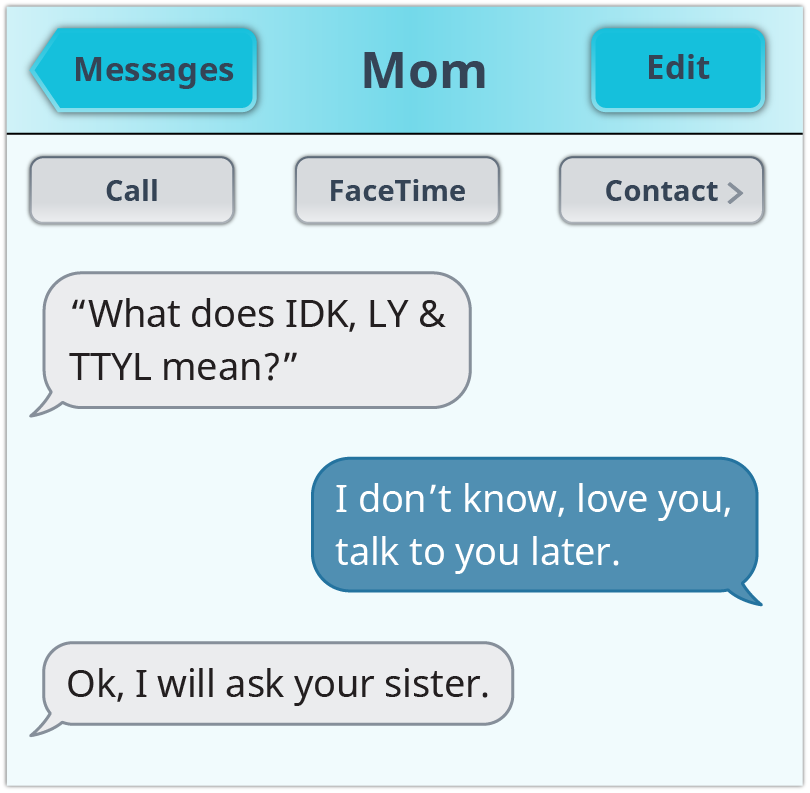
Although using the acronyms (symbols of communication) above allow us to do more in less space and time, we need to be careful about how we pass information to others as well as think more clearly about what is being communicated to us. Certainly, with the scope of the Internet we are seeing briefer messages, a wider reach, and greater immediacy.
You are aware that the transfer of information can be done vocally—voice, phone, face-to-face, over radio or television. It can come to us in a written format such as correspondence or printed or digital media. We obtain information visually in logos, pictures, maps, menus, and street signs. And, of course, we find ourselves learning things nonverbally by observing body language, tone of voice, gestures, and so forth.
Communication means that there is at least one sender and one recipient, and in between, there is the message. The kind of communication tool you choose to use also has an effect on the message being conveyed. Will you choose a pencil? Pen? Phone? Email? Text? Picture? Or perhaps a face-to-face opportunity? Whatever you choose as your method of communicating with one person or a group of people guides how effectively you send your message. Additionally, there are always emotions behind a message. You could just be sharing a picture of yourself on the beach or sending out a call for help on a class assignment, or perhaps feeling sad because a friend is sick. Each of these would affect how you might communicate.
Have you ever sent a message to someone too quickly? For example, you heard that a friend just broke up with her boyfriend and is terribly heartbroken. You immediately think you should send some kind of “hope you are ok” comment and decide to use Facebook to do so. Later you find out that she didn’t want people to know about it at all and you kind of jumped the gun on your condolences. How did you feel? Could you have gone about it in any other way? Perhaps waited until she told you about it herself? A private email or phone call? This is one of those situations where you have to step back for a moment and clarify for yourself that what you are about to send will be received the way you intended. Learning a little about the concept of emotional intelligence (EQ) will also be helpful to your decision about how to communicate in various situations. More on that concept will be discussed in the sections on listening and miscommunication.
Additionally, there are other significant variables that play an important role in communicating. These range from ethnicity to culture to age to gender and are meaningful to what one is trying to “say” to someone else. Unfortunately, sometimes the message is lost or misconstrued because neither the sender nor the receiver has taken into account these important aspects of successful communication. You will learn more about this later in the chapter.
Context of Communication
It is also essential to understand the context of your communication. In other words, to whom are you talking? Why are you talking to this person or people? What, exactly, do you hope to achieve out of the communication you initiate? An effective communicator understands the audience to whom they are trying to send a message. This means that you use the correct venue—face-to-face conversation, phone, email, text, written letter, picture, or whatever else makes the most sense in a particular situation. This way your message can reach your audience (professor, boss, colleague, friend, parent, teammate) in a productive way, and hopefully the message you intend to convey is received accordingly.
An example of context might be the following: you need to ask your professor about a grade you received on an assignment because you think the grade was too low for the work you did. Would it be appropriate for you to send a text asking why you received the grade? Might it be better to give your professor a call and hope she is available to talk with you? Or do you think it could be more useful and productive if you found out the professor’s office hours and went in to discuss your concerns in person? These are decisions you have to make carefully so you can make the most of what you are trying to communicate.
Listening
Another aspect of communication is the art of listening. Remember, communication is a two-way street. It is not enough to just send out a message. One has to listen carefully to the response, and not only listen, but understand that the audience receiving your message might have a very different take on the topic. As noted earlier, this could be due to gender, age, culture, and so forth. All of these have an effect on how well the communication is transmitted and received. Later in this chapter we will discuss the difference between just “hearing” the response and actually “listening” to the response. Optimal communication occurs when both parties actively listen. And finally, it comes down to this: communication is any act that involves a sender and at least one receiver, where a message is conveyed and hopefully the message is received correctly.
“We all feel better when we feel listened to. And we feel even better when we feel understood. In order to be understood, we must be listened to. Often it is more important to us to feel heard than to actually get what we said we wanted. On the other hand, feeling ignored and misunderstood is literally painful whether we are six or sixty.”5 — Steve Hein
Many variables get in the way of messages being received correctly. One of these is emotion—both yours and that of the person with whom you are trying to communicate. Sometimes you have to use emotional information to help you make a decision about how you are communicating. What this means is that you need to be able to understand your own feelings and those of others. There are five components (self-awareness, self-regulation, motivation, empathy, and social skills) to emotional intelligence. Understanding how these components work to help you get in touch with your and others’ emotional sides is an important part of listening.
Ultimately, communication is about information. The message you are sending may be as simple as one word (or even one letter), or as complex as an application for an internship. How you act on that information, how you expect others to act on it, and how it becomes knowledge are all part of the complexity of communication.
Questions to consider:
- Does everything I say or write have a purpose?
- Do I expect a response or a result from my communication?
- Do I change how I communicate depending on what response I want or need?
“The difference between the right word and almost the right word is the difference between lightning and the lightning bug.”
— Mark Twain6
Does Everything I Say or Write Have a Purpose?
There are many reasons that communication takes place. Some of our communication might be simply an attempt at being cordial and friendly. For instance, we might like to say hello to a friend down the hall, give a shout-out on Twitter to a family member living in another state, say “excuse me” to someone we’ve just bumped into, smile at a baby in a stroller going by, post a picture of our birthday party on Facebook, and stop to pet a new puppy in the park. Or maybe we just need some information, such as asking an instructor for guidelines for a project, telling a store owner what we are looking for, or going up to a stranger for directions to the nearest bus stop. As you can see, almost everything we do on a daily basis has something to do with communication. Additionally, we can communicate the same information to a wide range of people, and how this is received can vary greatly.
Another important purpose of communication is to forge relationships, whether these are of short or long duration or for particular purposes. What kind of relationships do you hope to develop when using various forms of communication? Are you looking for a partner for a project, or perhaps a date for the football game, or just want to nurture the relationships you have with friends already? The impact of flawed communication on relationships can be long-lasting, so it is important to be thoughtful when posting your thoughts and ideas.
Do I Expect a Response or a Result From My Communication?
There are times we are just sending out messages or information and not expecting a response, except perhaps a “like.” For instance, your friend posts a picture of her new dog on Instagram and you click on “like.” Other times we try to communicate an idea or ask a question and we do want a response, such as “What time is the exam on Friday?” This response is possibly from one person or many. There are instances when you need information, and you will either ask someone, do some web searching, or make a phone call to get the information that you need. Depending on what your need is, you must consider what form of communication will work best and get you the most satisfactory results. Your purpose for communicating is to get some kind of reply.
What Do I Bring to My Communication With Others?
You probably haven’t thought of this, but whether you actively communicate or not, you are still communicating. Your facial expressions, body language, what you are wearing, your hairstyle, body art, where you choose to sit or stand in a room, the people you associate with, eye contact or lack thereof, and any other mannerisms that you have are a form of communication. We all pick up signals from each other in these nonverbal ways. So even though you might be shy, or reserved, or not interested in any interaction at all, you are still communicating some information to others.
Questions to Consider:
- Is technology vital to your ability to communicate well?
- Are there rules to follow when using communication technology?
- How do you take control of your online communication?
“Now we know that once computers connected us to each other, once we became tethered to the network, we really didn’t need to keep computers busy. They keep us busy.”
— Sherry Turkle7
Is Technology Vital to Your Ability to Communicate Well?
Over a billion people use chat rooms, mailing lists, instant messengers, social network services, newsgroups, games, wikis, blogs, and more in order to share social relationships and organize collective action. Everything is connected: people, information, events, and places, all the more so with the advent of online social media. You live in a world where the traditional forms of education, conversations, relationships, and social activity in general have been transformed by the ubiquitous presence of technology. Digital media affects every student’s life and that of their families, friends, and the wider community. Most of you have grown up while this transformation has taken place. The new technologies have created dramatic changes in the relationship between people and information. Though you will come across people who don’t want to believe that these new technologies are here to stay, we, as humans, will never be able to separate ourselves from our own inventions, and trying to do so is perhaps only a step backward in an evolutionary sense. Therefore it is important that we learn to adapt our behavior to include the new inventions. Technology, after all, is an extension of the human mind, and the new technologies are only tools we have created over years of fashioning new ways to do things.
We continue to move from simple to complex tools. Advancements of technology go hand in hand with changes in communication options. The telegraph was replaced with landlines, those went out of style as the cordless phone became available, and this phone eventually morphed to a cell phone. When the Internet became accessible by cell phone, cell phones became devices that revolutionized personal communication.
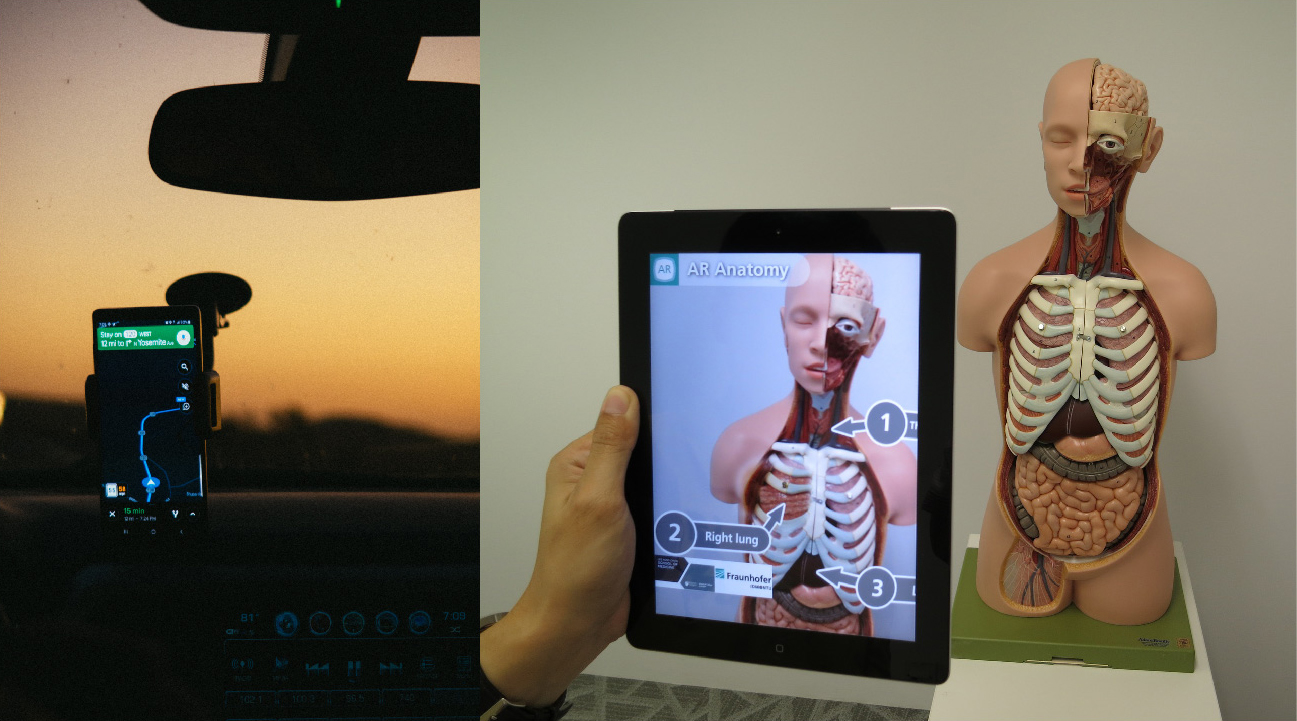
The following activity is a good way for you to reflect on your own use of technology. It is always interesting to step back and actually see what platforms you use and how much time you spend using them.
ACTIVITY
Share your personal story about when you started using social media. Include what social media you use, how you use it, and how much time you spend doing so. At the end of this story, discuss what you might like to see in the future of social media. What other communication technologies do you wish were available to you, and why?
Are There Rules to Follow When Using Communication Technology?
Did you find anything significant about how you use social media? When you carefully looked at how much time you spent on the different platforms, were you surprised? It is probably a good thing to sometimes step back and take a look at how we use our communication tools, and even more importantly, we need to ask ourselves if we are using them to our advantage and not just to pass the time.
Netiquette
Just as it is important to know your responsibilities in using communication technologies, it is necessary for you to understand that there is a code of honor and etiquette to go along with them.
Here are a few pointers on how to go about being active on the Internet without offending or annoying others.
- Don’t write emails, post to social media sites, or talk in chat rooms in ALL CAPS. CAPS can be interpreted as screaming or talking in a very loud voice.
- Don’t make fun of others.
- Apologize if someone was offended and did not “hear” what you were saying in the way you meant it.
- When stating a strong opinion, it is not a bad idea to use the abbreviation of IMHO (in my humble opinion). It might keep people from reacting strongly right back at you.
- Remember, no one can hear your tone of voice or see your facial expression, so use words carefully to get your message across.
- Be respectful of your audience with the level of familiarity used.
College Netiquette
While these Netiquette guidelines are applicable in nearly every environment, communication in college may have additional or more stringent rules to consider. Always be particularly mindful of how you communicate in any official environments, such as online courses, course discussion boards, and even on social media specifically related to your college, such as a club or team page.
For example, if your political science class requires students to post in a discussion forum after each night’s reading, students may have the opportunity to argue about issues or politics. Vibrant discussion, and even argument, may be acceptable, but personal attacks or insults won’t advance the discussion and could result in more significant consequences. Just as you wouldn’t—and couldn’t—become overly animated in an in-class argument, online arguments should remain civil. The goal is to make your points with evidence and reason, not emotion and assertiveness.
Finally, just as a note of caution, college codes of conduct regarding communication often apply to any interaction between members of the community, whether or not they occur on campus or in a campus online environment. Any inappropriate, offensive, or threatening comments or messages may have severe consequences.
Our communication in college conveys how we feel about others and how we’d like to interact with them. Unless you know for certain they don’t like it, you should use professional or semi-formal communication when interacting with college faculty and staff. For example, if you need to send a message explaining something or making a request, the recipient will likely respond more favorably to it if you address them properly and use thoughtful, complete sentences.
In a similar manner, you can make or break relationships with your classmates depending on how you communicate with them. Consider the following scenario:
Demetrius sends an email to several classmates about the details of a group assignment. He asks about availability and about which member of the group will take responsibility for which aspect of the project. He’s received four responses addressing availability, but no one volunteers for the responsibilities. Demetrius replies to all with an attempt at creating a division of responsibilities by typing different names next to each role. He uses ALL CAPS to make sure his classmates notice the suggestions. Lee responds immediately. They don’t like being forced into a specific role, and think Demetrius should have waited until the first group session instead of forcing his opinion on the group. Shirisha jumps in to mention that she’s upset Demetrius chose to put her in a non-speaking role of recording secretary.
What mistake did Demetrius make? How might he have handled the situation more smoothly?
You most likely have considerable experience on a variety of social media platforms. Can you add three more suggestions for how to navigate these sites politely and with consideration for others?
Now, add three suggestions specifically related to considerate communication in online educational environments.
How Do You Control Your Online Communication Strategies?
“Whether digital media will be beneficial or destructive in the long run doesn’t depend on the technologies, but on the literacy of those who use them.”
— Howard Rheingold
What is important is that we have to decide what we are going to do with the new communication tools for our future. We need to understand when to log on and when to log off. These days you sometimes find yourself being bombarded with new technologies and social media platforms, and you don’t know how you will keep up with them all. You have multiple sites sending you continuous notifications and find yourself scrambling to look at them and perhaps respond. Perhaps turning off those notifications will free up your mind a bit. Sitting at your desk in your dorm room and trying to do an assignment for a class can be difficult if your phone is blinking messages at you continuously.
It is probably important sometimes to take the focus away from the media itself and look at oneself. What is happening to our minds, our sense of self, and our ways of representing ourselves to others when we spend a significant portion of our time on various online sites? How do we mediate our relationships differently? What kinds of signals do we send, knowingly and unknowingly? Are we shaping the media we use, or is it shaping us? Sometimes we hide behind our on-screen identities as well as navigate social media sites in ways that make us communicate with people that are like ourselves. Do we use these new communication tools appropriately?
The following activity might help clarify how well you utilize your social media platforms.
Go outside your usual comfort zone and friend group. Find someone with whom you disagree, and think about how what they said had an effect on you. Did they use correct etiquette when saying what they said? If you respond, what would you do to make certain your response was heard correctly and was not offensive?
Ways to Take Control of Your Online Communication
Howard Rheingold, a technology guru who coined the term “virtual community” in 1993, has been thinking and writing about the changes that technology has been making over the years. He has come to the opinion that in order for us to deal with the new communication opportunities, we must learn about what he calls “mindful participation.”8 Rheingold doesn’t suggest, as many others do, that these new technologies are bad for us. He offers ways to engage online that keep us in control of our actions and make us a bit more productive about our use of online platforms. He believes in social media literacy and suggests that learning the following five literacies will make our life on the Internet more productive, less stressful, and ultimately more enjoyable. If social media is our most often used form of communication, then the following five literacies should help us manage our time online and keep us in control of the tools we use for purposes of communication.
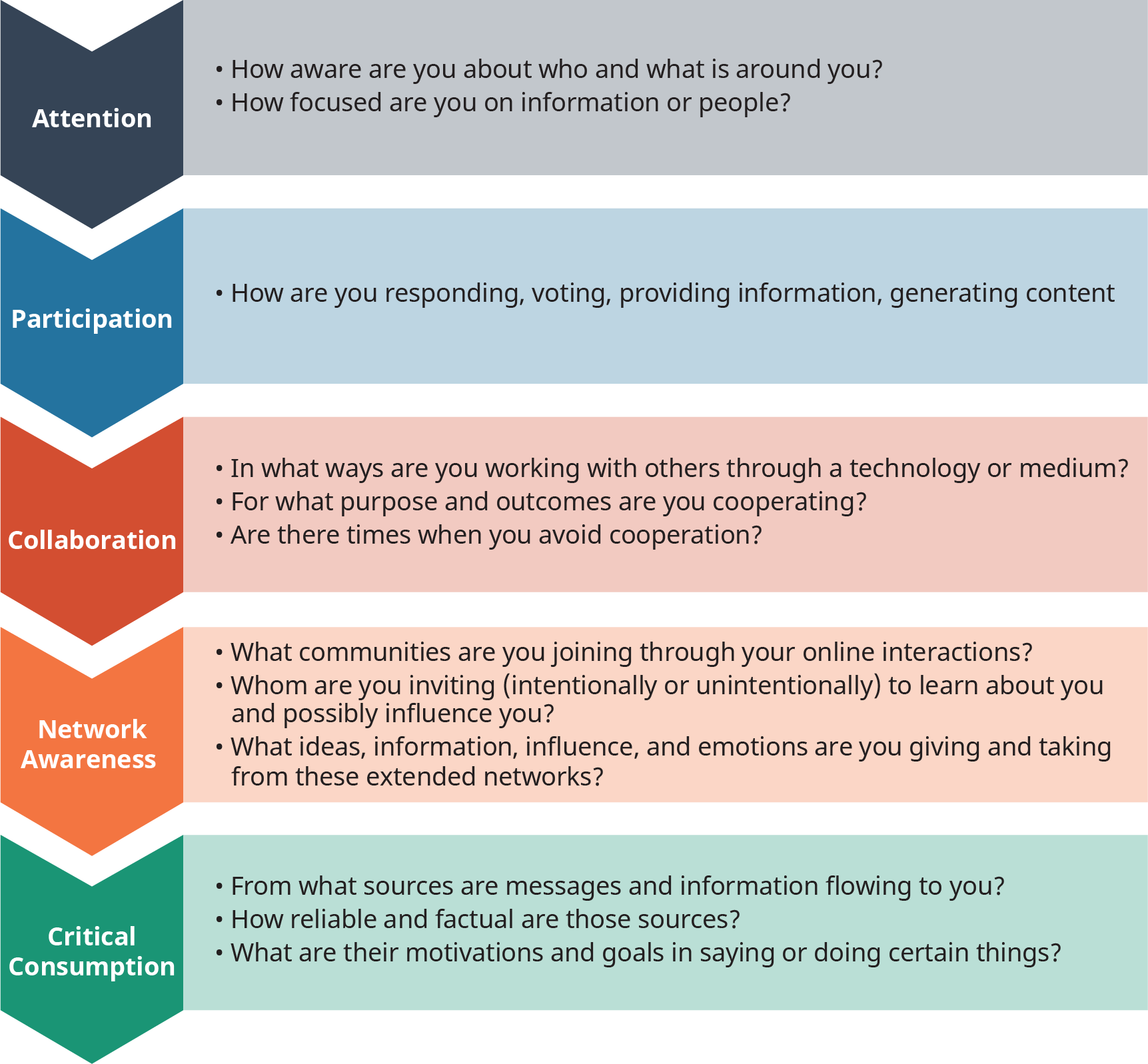
Attention
Attention is the first literacy and is the fundamental building block of how individuals think. It is sometimes difficult to focus our attention since our minds tend to wander in a random manner. It is therefore essential that you become more aware of how you are directing your attention. Consider being in a lecture hall and trying to focus on the professor and what she is saying. Is your full attention there? Are you also scrolling through some social media feed while listening to the lecture? When you are in your dorm room working on a class assignment, are you also watching your social media notifications, listening to music, talking to your roommate, and clicking on various ads on a website? On what is your attention most focused? Probably on everything and consequently on nothing. Learning how to pay attention to what is most important at the moment will help you fine-tune your skills.

Participation
And even though you might be really good at using online applications and connecting with friends, that does not necessarily mean that you always understand the implications of your participation or that you are actually participating.
Participation, the next literacy, is much broader as it recognizes the vast population of users that are connected. Participation is connecting with the tool, not people. It is a way of becoming an active citizen and not just a passive consumer. There are multiple ways to participate on a variety of social media platforms. In fact, you probably don’t realize that clicking on a “like,” making a short comment on a picture, or whatever else one does on a site is actually participating. Of course, the effect of your participation can vary, but it can also be very powerful. You participate when you post, fill out a survey, start your own blog, respond to others’ blogs, or just watch a video on YouTube. All of these actions are a form of participation.
In college, participation with communication environments and other resources is often essential for success and for your grade. If you use learning management systems, online homework systems, polling or attendance software, or other educational media, you need to understand the levels and types of participation, as well as the implications of each. As with social media platforms, learning technology can be a powerful tool, and you’ll likely engage with it throughout your academic and even your professional career.
Collaboration
The third literacy, collaboration, refers to your being able to work together using technology. Doing things together gives us more power than doing them alone. Think of all the times Twitter was used by multitudes of people to pass on information about major storms. When there was a bombing in Paris, people went to Twitter to let those people in the streets who’d been displaced know they had apartments and homes that they would open up to them. Of course, there are many collective intelligence projects, such as helping Coke come up with a new flavor, or GoFundMe sites to help people in need of money for health reasons. The collaborative efforts of people communicating around a big project are endless and a perfect way to use communication technologies. Tools allowing collaboration allow you to share resources and work as a team, and build on each other’s ideas.
hink of a time when you collaborated with others to get something done. This could be organizing a party, planning transportation to an event, doing a school project, building a stage for a play, or any other activity that was done as a group. What forms of communication did you use to work as a team? How did the environment and the other people in the group influence tools and methods you used? Complete the table below to illustrate the challenges, opportunities, and communication approaches you might use (or have used) for each situation.
| Challenges | Opportunities | Communication Methods and Tools |
|
|---|---|---|---|
| Group project for an on campus (traditional) course. | |||
| Group project for an online-only course. | |||
| Planning an event with your extended family. | |||
| Planning an event with your friends/peers. |
Network Awareness
Network awareness is the fourth literacy. Technological networks now allow us to have a greater number of people we can contact. These networks multiply human capacity for social networking and allow connection in a matter of seconds. You can become a member of newsgroups, virtual communities, gossip sites, forums, and other organizations. Making use of these possibilities expands your ability to contribute to the vast stores of information on the Internet. At the same time, you should be conscious of the people whom you’re inviting to hear you and influence you. Have you ever been intrigued, angered, or persuaded by a friend of a friend (someone you don’t know at all) who commented on a social media posting? If so, you are in a relationship with that stranger, and they are affecting you.

Critical Consumption
The last literacy, critical consumption, helps us to discern what is true and what is not. We have to learn how to differentiate fact from fiction. Humans have a difficult time trusting people in everyday life; this also translates to the millions of people on the Internet using social media. Before believing what others have written, communicating with them, or using a tool, it is wise to do some detective work. Check the claims, the author’s background, sources, and accuracy.
Critical consumption is closely related to Informational Literacy, which is discussed in Chapter 7 on Thinking.
Evolving Our Strategies to Match Our Evolving Technologies
Communication has changed because of the way we are using technology. Yes, we still write and talk, but where and how? There are myriad social media platforms that you can use for communication, from Snapchat to Twitter, each with its own set of rules and limitations. These platforms have completely changed many of the ways we transfer ideas and information, find romantic partners, keep in touch with friends and family, connect with our professors and classmates, make plans with teammates, look for employment, and so much more.
When using a device for communication, there are fewer nonverbal cues we can pick up on, only what the other person is posting or showing. In certain situations, such as talking on the phone, a person can’t see hand gestures but can still hear a tone of voice. When typing, however, there is no tone of voice or hand gesture or body language. Sometimes typing may not convey the same message as saying what you’re feeling.
Social media has made it easier to keep in contact with many people, but it also creates missed opportunities for new relationships since we are too often looking down at our phones instead of talking with the person standing next to us.
Technology has definitely had an effect on our society. Think about how it has this effect.
- Is that cell phone in your pocket something that has made life better?
- Are we empowering those who most often don’t have access to power in our society?
- Or are we further alienating them?
- Does the ability to access global communications create people who are more open and free with their ideas?
- Is an email to a colleague in another country more significant than a snail mail letter?
- Are there any new platforms or apps that you are reluctant to try?
Socialization is an integral part of human behavior, and over time new technologies have made networking and communication more complex. The tools you have available for communication within your networks are powerful and fulfilling, but they can also stand in the way of real-time thinking, doing, relating, and communicating. The past twenty years have seen an explosion in new tools and means of communication, but the next twenty may see similarly rapid growth and change. Adaptability may be as important a skill as any method specific to a certain platform. The key is mindfully participating and knowing when to use and when not to use the new technological tools available to us, which may require learning and acceptance. In this way your communication with others will be positive and allow you to be productive in all aspects of your life.
Information is processed and transferred faster than ever. Social media has become the place where people obtain information. This could be news on YouTube, shocking events on IGTV, or even fake rumors on Facebook spread from friends of friends. It almost seems that information can’t travel fast enough today, but it’s vital to take everything you see with a grain of salt and evaluate the information given based on what it is, its source, context, and credibility.
- The Verge published a how-to guide on checking facts and sources online.
- Social networking addiction occurs when people become so dependent on Instagram, Snapchat, Twitter, Facebook, and related platforms that all of their communication seems to take place within these virtual places. Many researchers conclude that addiction to social media is much stronger than an addiction to cigarettes or alcohol.
- Six Ways Social Media Changed the Way We Communicate discusses how our ability and need to share and consume information quickly can lead to changes in our relationships and ourselves. The article also provides related links.
Questions to Consider:
- Does my form of communication change in certain situations?
- Do I use an altered style of talking when I am with different people?
- What role does listening play in communication?
Does My Form of Communication Change in Certain Situations?
The circumstances surrounding a message provide the context. These include the setting you are in, the culture that guides you and whomever you are communicating with, and the purpose of the communication to begin with. Context also includes the values people have, appropriateness of the message, the timing you choose to convey your message, and the reason behind your wanting to communicate. This means considering your audience, the place, the time, and all other variables that impact communicating constructively.

Generally, all communication happens for a reason. When you are communicating with people, are you always on the same wavelength? Are you wide-awake and your roommate almost asleep? Is the baseball game really important to you but totally boring to the person you are talking with? It is important that everyone involved understands the context of the conversation. Is it a party, which lends itself to frivolous banter? Is the conversation about something serious that occurred? What are some of the relevant steps to understanding context? First of all, pay attention to timing. Is there enough time to cover what you are trying to say? Is it the right time to talk to the boss about a raise? What about the location? Should your conversation take place in the elevator, over email, in a chat room? Is everyone in the conversation involved for the same reason?
The following is an activity that might help you understand what is meant by context.
Analysis Question
Consider the context of a family dinner. You are at the table with siblings, cousins, parents, aunts and uncles, and grandparents. A wide variety of age groups are present around the dinner table. Are there any rules about how you behave in this circumstance? What are they?
Then put yourself in the context of a chat room with people you might know and some that you do not know. Are there rules for communicating in that situation? What are they?
Sometimes we have misconceptions about what is going on in a group situation. Perhaps we think that everyone there knows what we are talking about. Or we think we know everyone’s opinions on an issue or situation. Or we come into the conversation already thinking we are right and they are wrong. Communication in these instances can go very wrong. Why? We aren’t listening or even preparing ourselves adequately for the conversation we hope to have. So often we are only concerned about what we have to say to an individual or a group and we don’t step back long enough to reflect on what our message might mean to them. We seem to not care about how the message will be received and are often surprised by how poorly the communication actually went. Why? Because we didn’t step back and think, “Hmmmm, my aunt is a really religious person and probably would be offended by a conversation about sexual intimacy.” Or, “My father is having a bit of financial trouble, and this might not be the right time to bring up money I need for a new car.”
Do I Use an Altered Style of Talking When I Am With Different People?
There are so many instances in our lives when we think about our needs first and blurt out what we are thinking, leading to some critical misunderstandings. It is really important not only to be concerned about our need to communicate, but to take into consideration with whom we are communicating, when and where we are communicating, and how we are going to do so in a positive way. First, you should step back and think about what you want to say and why. Then reflect on with whom you are attempting to communicate.
- Of the following methods, which is your preferred method of communication?
- In person/face-to-face
- Voice call
- Video call
- Texting (including texting apps)
- Social media environments
- Which element of communication do you find most challenging?
- Understanding the audience/situation and using the best form/tone to fit it
- Speaking in front of a group of people
- Writing papers or reports
- Listening and interpreting
- When writing a paper for a course, which aspect do you find most challenging?
- Coming up with an original idea/thesis/research question
- Finding sources and background information
- Evaluating the quality of sources or data
- Organizing the paper
- Writing/editing the paper
- Writing the bibliography/works cited list
You can also take the anonymous What Students Say Survey below.
Students offered their views on these questions, and the results are displayed in the graphs below.
Of the following methods, which is your preferred method of communication?
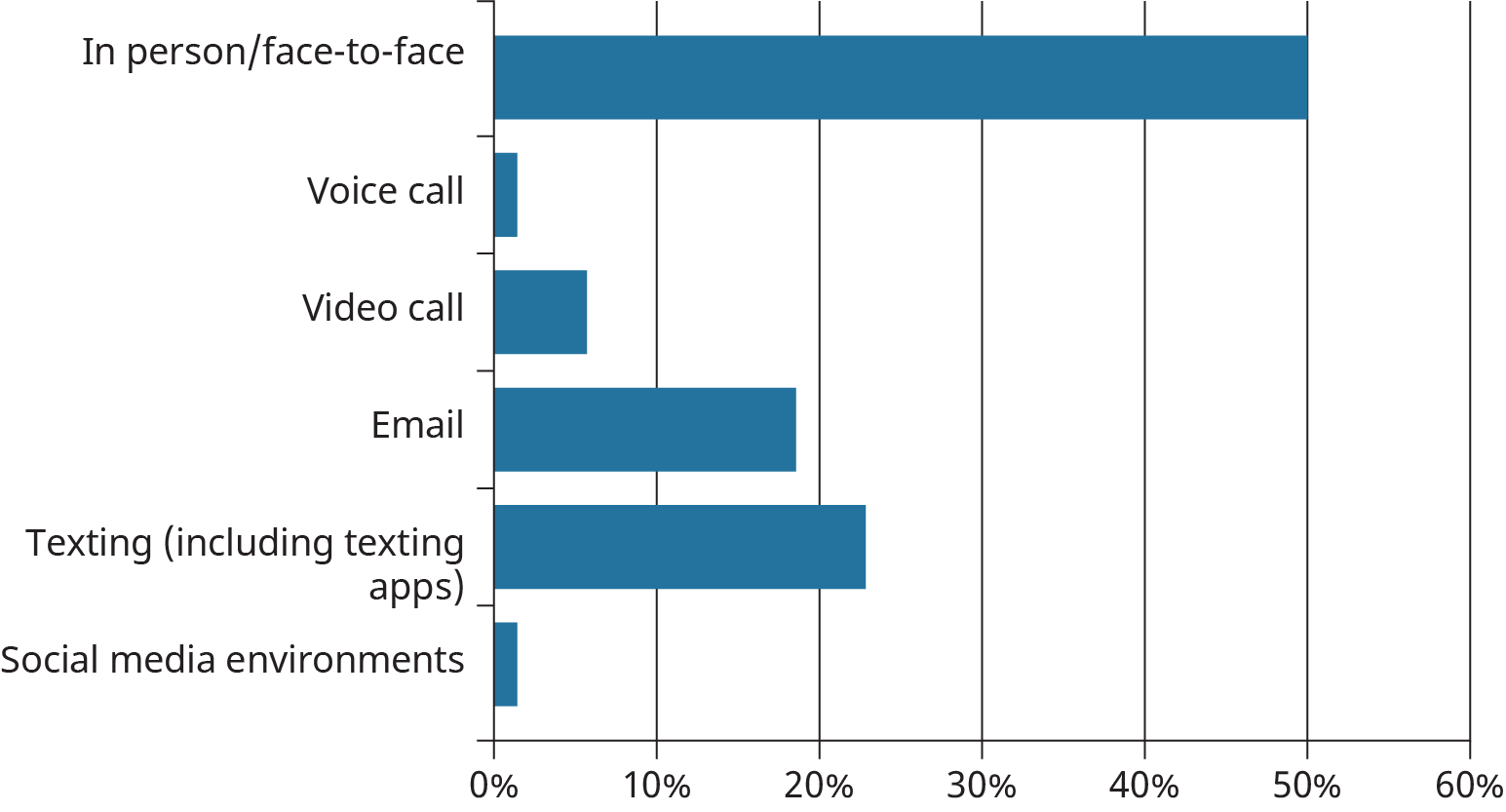 Which element of communication do you find most challenging?
Which element of communication do you find most challenging?
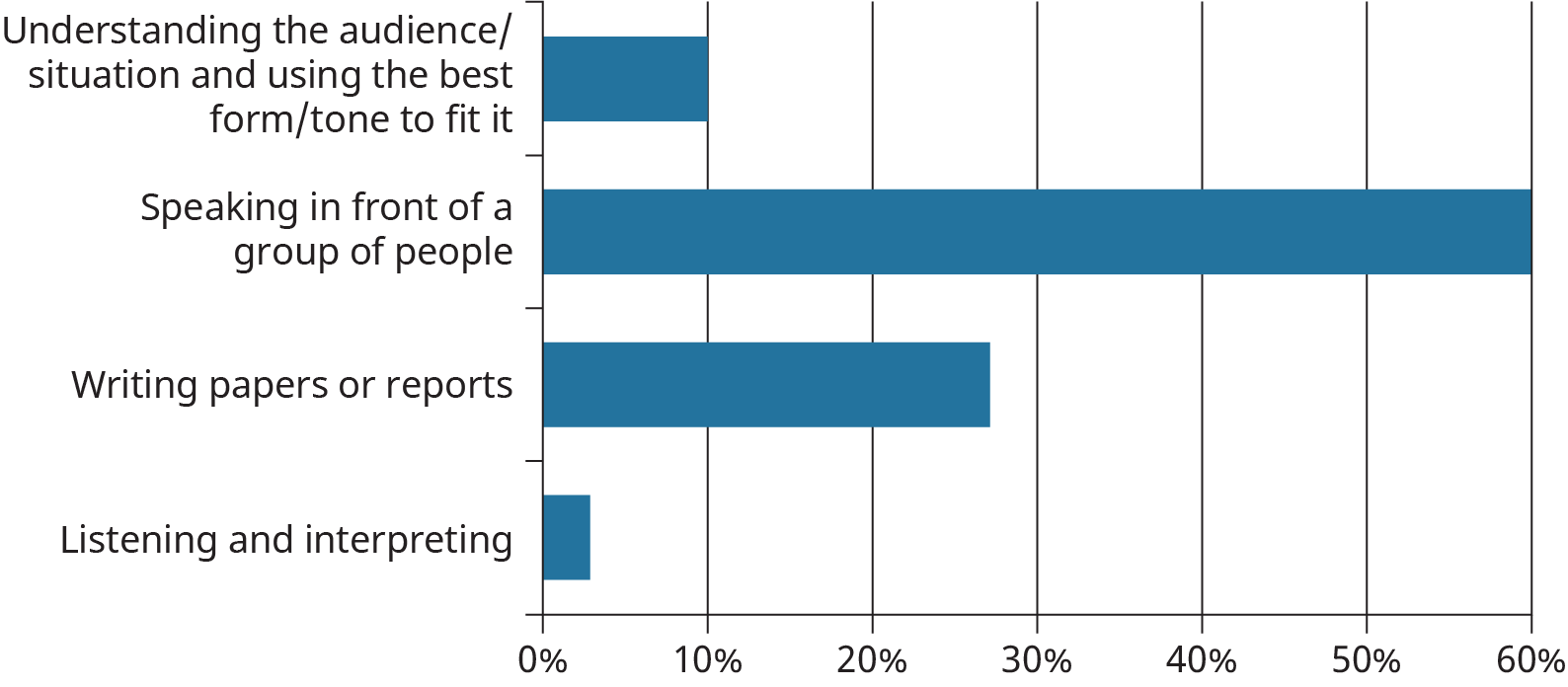
When writing a paper for a course, which aspect do you find most challenging?
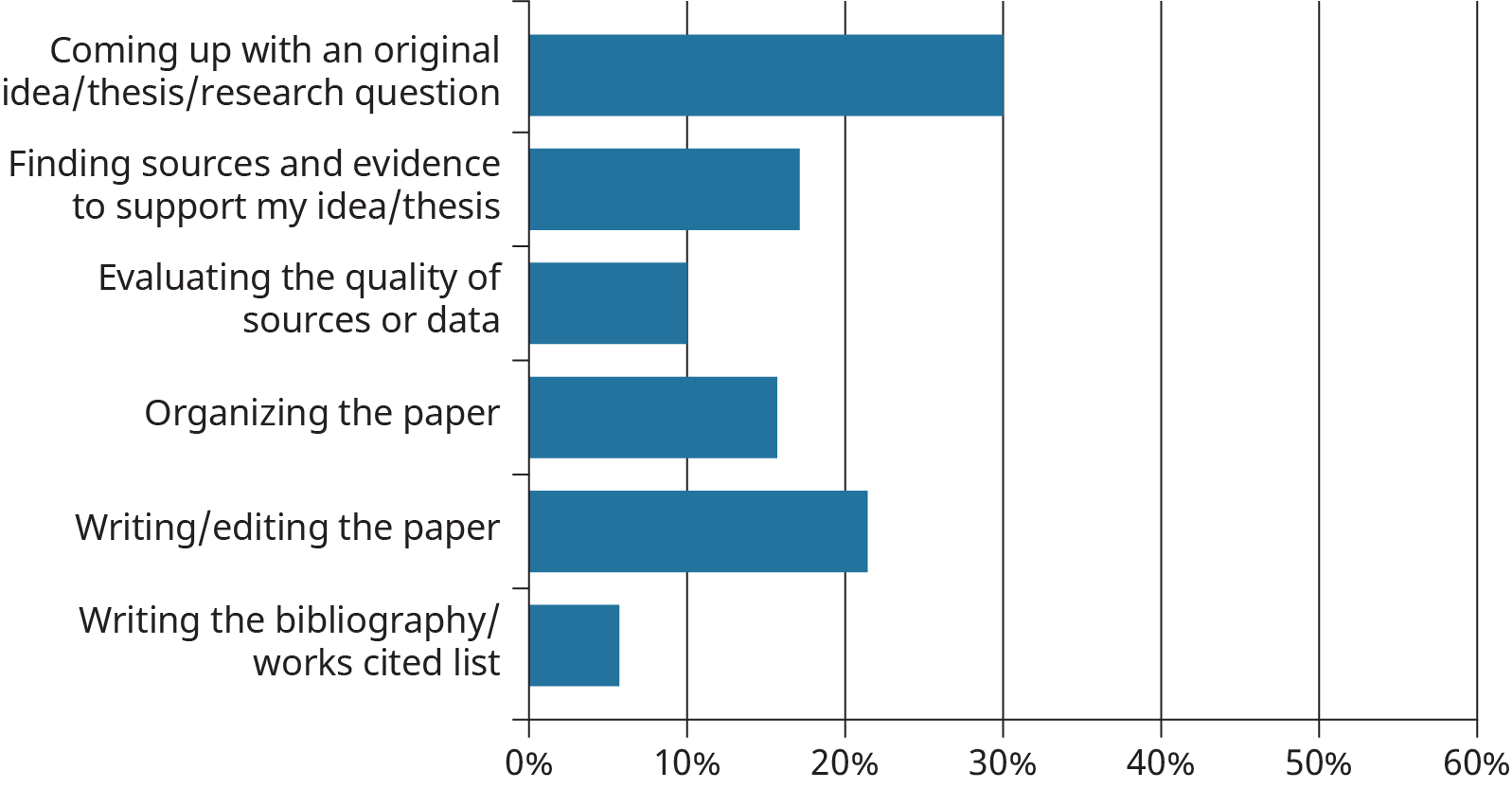
Emotional Intelligence
We’ve talked about emotional intelligence when it comes to listening. Recognizing your own emotions and those of others will help you avoid miscommunication as well. When you are aware of your own emotional state and you have the skills to address and adjust, your communication with others will improve. You’re less likely to blurt out an angry retort to a perceived criticism, for example.
You’re better able to manage communication when you recognize someone else’s emotions, as well. A conversation can veer into hostile territory if someone feels attacked, or perhaps simply because they’ve had an emotional experience related to the conversation that you don’t understand. Taking note of other people’s emotional responses during a conversation and listening and speaking with empathy will help you manage the situation.
When conversations begin to feel heated, it’s a good idea to pause and ask yourself why. If it’s you who are feeling defensive and angry, make an effort to recognize the source of your frustration and try to take a step back, perhaps leaving the conversation until you’re better able to control your emotions and communicate in a way that’s more clearheaded and calm.
If it’s someone else who’s emotional, again, ask yourself why. Can you see reasons that this person may feel attacked, belittled, or usurped? If you can recognize their emotion and address it, you may be able to get the communication back on solid footing.
Think of what context and what communication tool you would consider in the following situations:
- You need to let your professor know you won’t be able to hand in your assignment on time. What will you say, when and where will you say it, and what form of communication will you use and why?
- Your roommate wants to have friends over for a party and you aren’t sure you are up for that. What and how do you tell your roommate?
- The weekend is full of activities, but you are expected home for a family gathering. How do you let your parents know you aren’t coming?
Listening Is a Communication Action
Our communication includes both sending and, especially, receiving messages. Unfortunately, we often don’t take the time to focus on the latter part. Often we are already thinking about what we are going to say next and not listening to what is being said to us. This lack of focus occurs in intense, oppositional discussions, but it can also be common in one-on-one conversations and when someone is confiding in us. When we listen, we need to embrace the concept of empathy, meaning you understand what a person might be feeling, and understand why that person’s actions made sense to them at the time. This way our ideas can be communicated in a way that makes sense to others, and it helps us understand others when they communicate with us.
Even though it is silent, listening is communication. We can often “hear” what is being said but don’t really listen well enough to discern what is meant by the person trying to communicate with us. In order to listen effectively, we should consider it an active process, in the same way we think about speaking or messaging.
So what does active listening entail? There are some strategies you can use to help you become a good listener. First of all, stop talking. You can’t listen if you are talking. Secondly, turn off the television, put your phone in your pocket, silence the music and, if needed, go somewhere quiet, so you can actually focus on what is being said. Next, have empathy for the person talking to you. In other words, don’t begin thinking of ways to answer. Even if someone has a problem (with you or something else), avoid trying to immediately solve it; consider whether the person speaking to you really wants advice or action, or might simply want to be seen and heard. Finally, before you say anything as a reply, repeat what you heard so the other person can confirm that you heard them correctly. You would be amazed at how well these strategies work to help avoid misunderstandings and confusion.
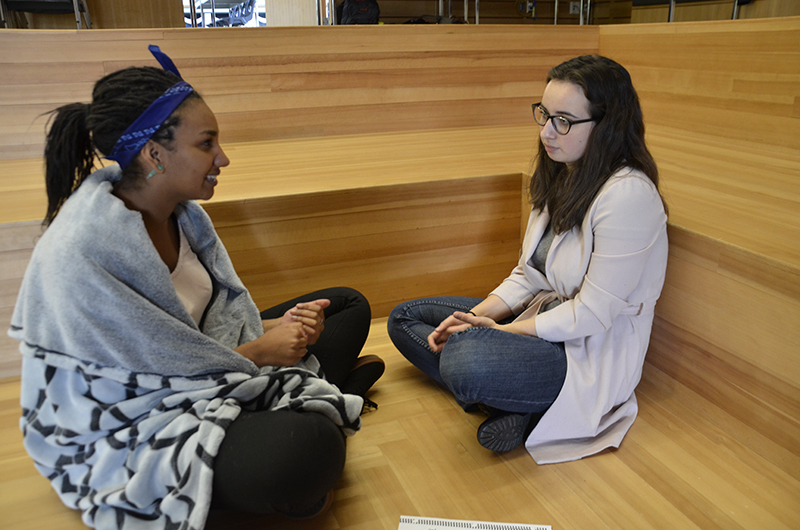
Think about all the times you have gone through a drive-through for food or coffee. The scenario is most often the same, right? You order, let’s say, medium fries, a burger with no cheese or onions, and a large soft drink. You then listen to the person inside the restaurant say back to you, “You want medium fries, a quarter pounder with no cheese or onions, and a large Coke.” If that is the right order, you say yes and move on to pay. This can be seen as active listening on both sides. The following activity can help you reflect on active listening.
This is an activity of self-analysis. As said above, listening and hearing are not the same thing, and the difference can often lead to faulty communication. Think back on a time when your attempt at communicating with someone (face-to-face or online) didn’t go the way you intended. The message you were trying to convey wasn’t received in the way you meant it, and this led to some discord between you and whomever you were “talking” to. Write down what happened. Then think a bit about what could have been done differently. Was the problem yours? Did you send a message that wasn’t very clear? Did the receiver of this message not really “listen” to what you were saying? What got in the way of what should have been just a simple bit of communication between you and someone else?
As said earlier, emotions are frequently involved in communication.It would be nice if everything was logical and everyone was always coming from that place of no emotion. But that’s not how it works in most instances. People have opinions, needs, desires, and outcomes they are looking for; feelings that can be hurt; and differing attitudes. The list could go on and on. What is important is that we need to be aware of our own emotions, and those of others, when attempting to communicate. Consider other people’s feelings as well as your own. Have empathy. And in the midst of trying to do that, listen, don’t just hear!
Questions to consider:
- Can you remember a time when you were surprised that what you communicated was not well received?
- What are some other barriers to effective communication?
“Words are the source of misunderstandings.”
— Antoine de Saint-Exupéry, The Little Prince9
Meredith and Anvi are working together on a project on marketing for a communications class: Anvi will create content for a flier, and Meredith will determine the best platform for advertising. In their brainstorming session the two realized they had some outstanding questions about how much content the flier should contain and whether they needed to turn in additional documentation. Meredith left it to Anvi to clarify this material since the content of the flier was her responsibility. Meredith waited impatiently the entire class session for Anvi to ask about the assignment. With class time almost up, Meredith spoke up, telling the instructor in front of the class that Anvi had a question about the assignment.
Anvi clarified the assignment with the professor, but when Meredith tried to find her after class to talk about next steps, Anvi had gone. Meredith was surprised to receive an angry text from Anvi soon after class accusing Meredith of embarrassing her. Anvi pointed out that she’d managed to complete every assignment so far in the course and she didn’t need Meredith to take over on this one.
Communication can go awry for a number of reasons. One could use jargon or technical language that is unfamiliar. There can be differences in the perception of an issue. People may speak different languages, or the colloquialisms that one uses don’t make sense to everyone.
As in the case with Meredith and Anvi, cultural considerations can also affect the way people communicate. Anvi, for instance, prefers not to speak to the instructor during class because she feels that she’s interrupting. She prefers to approach the instructor after class time is over. Meredith, on the other hand, usually has a task list she likes to tick off one by one to make sure everything is moving on time, and she can sometimes become insensitive to the communication styles of others.
Some barriers are likely to be emotional, often caused by topics that are sometimes considered problematic, such as sex, politics, or religion, which can interfere with effective communication. Sometimes what you are trying to communicate is embarrassing or otherwise a bit personal, and you kind of skirt around the edges of really saying what you want to say. Other emotions, such as stress, anger, depression, sadness, and the like, can have an effect on how well you communicate with another person, or they with you. Physical disabilities, such as hearing loss, can also come into play and get in the way of successful communication.
Some of our behavior and communication is based on previous encounters, and we don’t see past that and start fresh. Sometimes the barrier can be a lack of interest or attention on the part of the receiver. There are also expectations about what might be said or stereotyping on the part of the sender or the receiver. Often when we communicate with people we have preconceptions about who they are, what they are thinking, and how they will react to whatever we say. These preconceptions can get in the way of productive communication. A person could have an attitude that comes with whatever is being said or written. Or perhaps there is a lack of motivation to clarify what you want to communicate, and the end result is not what you were hoping for.
Take into consideration some of your own stereotypes and preconceptions, and try them out on the following scenario.
You are walking down the street and need to ask someone for change for a dollar because you need it for the parking meter. There are only a few people around you, and you have to choose whom to ask for help. Which person would you choose, and why?
- A person with tattoos all over their arms
- An elderly woman who is hunched over and walking gingerly
- A person of color who is absorbed in their own phone
- A parent with three children who is frantically trying to keep them together
- A well-dressed man, with shiny leather shoes, walking briskly to wherever he is going
Preconceptions and Assumptions
Have you ever thought about the message you are conveying to others? If you were the one standing on the street corner, what would others see? How do you play into others’ preconceptions simply based on your appearance?
Of course, you should be yourself, but certain environments or situations require us to consider and, perhaps, change our appearance. Wearing a T-shirt with a “message” may be appropriate when you’re at leisure, but you wouldn’t wear it to a job interview.
College presents us with many situations where people’s preconceived notions of our appearance may come into play. For example, while it might not be fair, faculty may have a certain perception of students who attend lecture or office hours in pajamas. Consider the implications of sitting in your instructor’s office, asking for help, when they think you haven’t changed your clothes since you woke up. You are absolutely free to express yourself in a certain manner, but your appearance may miscommunicate your motivation or intent. Recognizing how our own preconceptions come into play, and acknowledging those of others, generally leads to more effective interactions.
One of the biggest changes about the way we interact is the vast number of people available with whom we can communicate. This is a wonderful thing as we get to meet many people from diverse places. It can also be challenging because we are not always prepared to communicate with people from varying cultures, genders, ages, or religious and political views. Sometimes a simple lack of familiarity can lead to errors or even offense.
Think about how you communicate to different types of people. For each person in the left-most column and each example of something you need to describe, write some notes on how you might communicate, the types of words you might use, or what you may consider when speaking to them.
| Describing a sporting event you watched. | Describing an argument you got into on social media. | Describing a night out with friends. | |
|---|---|---|---|
| An eight-year-old | |||
| A 20-year-old woman | |||
| A middle-aged man | |||
| An elderly person |
Did your answers come from stereotypes or experience? (Or both?) Did you choose your words carefully with the child? Did you assume the man would know more about sports than the woman? Did you assume the elderly person wouldn’t know about Twitter or Instagram? Perhaps being mindful in your interactions with others will help bring clarity to your communication.
Unfortunately, relying on stereotypes often results in failed communication. Our understanding of others is often masked by the stereotypes that have infiltrated our society. Think about if you bring your own stereotypes to the table. Do you think others do the same? If so, those probably get in the way of a successful conversation.
Look in more detail at the issues of stereotypes, assumptions, and avoiding offense (microaggressions) in Chapter 9.
“Precision of communication is important, more important than ever, in our era of hair trigger balances, when a false or misunderstood word may create as much disaster as a sudden thoughtless act.”
— James Thurber10
How Can Identities and Experiences Lead to Communication Barriers?
Aside from our actual communication abilities and tools, we bring to each interaction many unique aspects based on who we are and where we come from. Diversity, as important and great as it is, requires us to consider the different perspectives and experiences others bring to a discussion or interaction, and to understand that our own views and contexts may be unfamiliar to others. While we shouldn’t shy away from this diversity, we should exercise patience and practice when communicating with new people.
Part of this consideration is known as cultural competency, which you’ll learn more about in Chapter 9. Below are several aspects of people’s lives that you might consider when communicating.
Identity is generally a feeling of belonging to a group. It is your self-perception and is usually related to nationality, ethnicity, religion, social class, sexual orientation, gender, generation, region or any social group that has its own distinct identity. Examples of cultural identity markers include the rituals people observe, the music that a group prefers, the style of clothing that is worn, the languages actual ethnic group one belongs to and its various foods and celebrations, or possibly the games that are a preferred sport in some communities. All of these variables can constitute a cultural identity for people. And belonging to these groups gives people an identity and a frame of reference on how to communicate and relate to the world around them.
Gender identity refers to the deeply held, internal sense of a person’s gender. Sometimes, a person’s genetically assigned sex does not line up with their gender identity. These individuals might refer to themselves as transgender, nonbinary, or gender-nonconforming. 11 Thus, gender is what a person identifies with.
While gender is internal, social influences and perceptions can shape a person’s attitude and method of communication. For example, in some families and cultures, men are raised to be more dominant or less emotionally expressive. Their use of that approach may lead to communication problems with others. However, people’s assumptions about men may also lead to communication problems. The same can happen with other gender identities.
What are your communication experiences with different genders? Have you seen people communicate a specific way based on the genders involved in the conversation? For example, does a classmate have a way of speaking to men that is different from their way of speaking to women? Does that difference become a barrier or issue in the communication?
Age can have a very significant impact on communication. This is a little easier to understand, as people from varying generations bring very different experiences to their contact with others. We all grow up surrounded by certain music, clothing styles, language, and cultural influences. Modes of parenting have evolved, food choices have expanded, and tragedies and world politics have occurred, and each of these had an effect on the generation that experienced them firsthand. And, of course, most of us live or have lived with multiple generations in our lives and have experienced many of the differences ourselves. Think of the times you’ve tried to explain what you do on your social media platforms to your grandparent (though some grandparents are pretty good at all the new technologies!). And think of how very young family members—age three or four—describe the videos they watch or the games they play.
As you can see from the above categories of cultural identity, gender, age, and our own stereotypes about people, there are many barriers that can come into play when you are trying to communicate with someone. In fact, on a college campus you probably will run into a large variety of differences in the people you meet. Many come from other countries, cultures, religions, and family backgrounds. Some may be in the country solely for the purpose of going to college, and intend to return home when they graduate. Some may have a lot of life experience, while others could be high school students in a dual enrollment program. All of that will have an effect on how they communicate, as your own upbringing and experiences have had an influence on who you are. Keep that in mind as you try to create relationships with the many people that are available to you, both face-to-face and online.
Footnotes
- 1 “Is Anybody Listening?” William H. Whyte and the editors of Fortune Magazine. Simon And Schuster. 1952. (Note: Often misattributed.)
- 2 Sommerville, Joseph. The Five Keys to Interpersonal Success. 2004.
- 3 In Merriam-Webster online dictionary: https://www.merriam-webster.com/dictionary/communication
- 4 Definitions of Communication. Communication Theory.Org. https://www.communicationtheory.org/definitions-of-communication/
- 5 Hein, Steve. “Listening.” Eqi.org. http://eqi.org/listen.htm
- 6 The Art of Authorship: Literary Reminiscences, Methods of Work, and Advice to Young Beginners, Compiled and edited by George Bainton. 1890. Section: Mark Twain
- 7 Turkle, Sherry. Alone Together. New York: Basic Books. 2011.
- 8 Rheingold, Howard. Net Smart: How to Thrive Online. Cambridge: MIT Press. 2012.
- 9 Saint-Exupéry, Antoine de, and Katherine Woods. The Little Prince. New York: Harcourt Brace Jovanovich, 1961.
- 10 Thurber, James. Lanterns and Lances. Harper and Brothers. 1961.
- 11 Newman, Tim. “Sex and gender: What’s the Difference?” Medical News Today. February 7, 2018 http://www.medicalnewstoday.com/articles/232363.php
Source: OpenStax College Success is licensed under Creative Commons Attribution License v4.0

